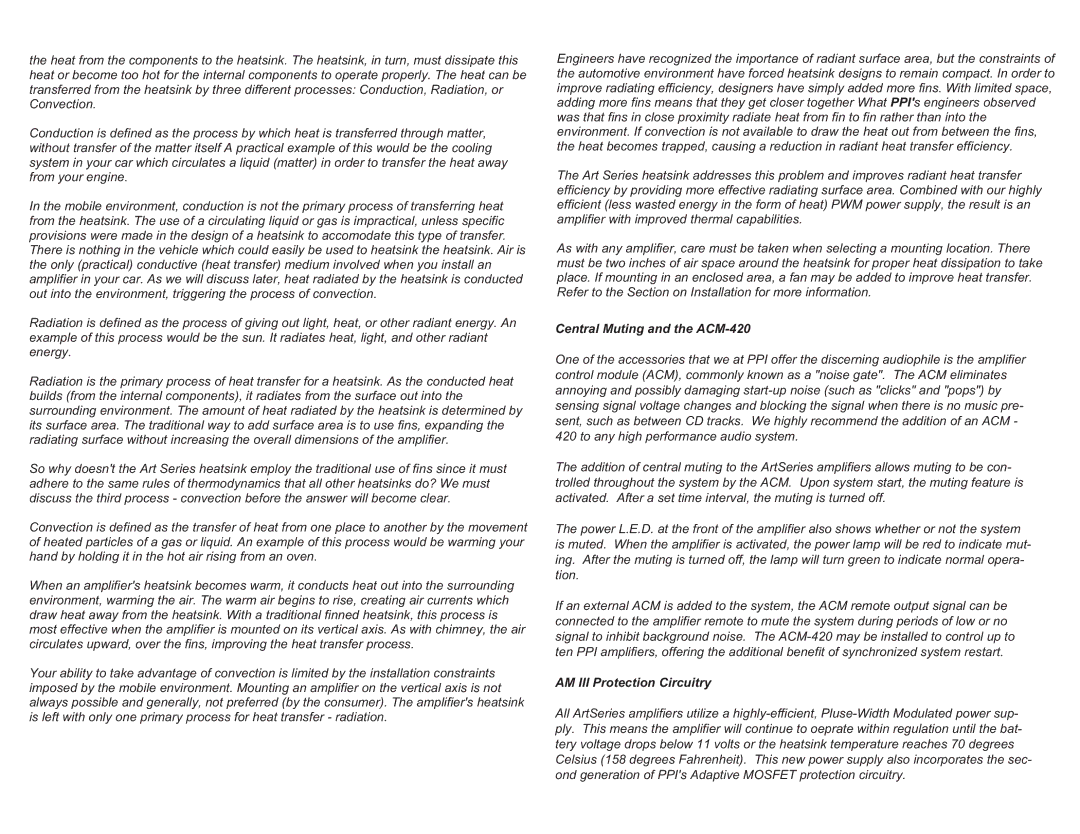the heat from the components to the heatsink. The heatsink, in turn, must dissipate this heat or become too hot for the internal components to operate properly. The heat can be transferred from the heatsink by three different processes: Conduction, Radiation, or Convection.
Conduction is defined as the process by which heat is transferred through matter, without transfer of the matter itself A practical example of this would be the cooling system in your car which circulates a liquid (matter) in order to transfer the heat away from your engine.
In the mobile environment, conduction is not the primary process of transferring heat from the heatsink. The use of a circulating liquid or gas is impractical, unless specific provisions were made in the design of a heatsink to accomodate this type of transfer.
There is nothing in the vehicle which could easily be used to heatsink the heatsink. Air is the only (practical) conductive (heat transfer) medium involved when you install an amplifier in your car. As we will discuss later, heat radiated by the heatsink is conducted out into the environment, triggering the process of convection.
Radiation is defined as the process of giving out light, heat, or other radiant energy. An example of this process would be the sun. It radiates heat, light, and other radiant energy.
Radiation is the primary process of heat transfer for a heatsink. As the conducted heat builds (from the internal components), it radiates from the surface out into the surrounding environment. The amount of heat radiated by the heatsink is determined by its surface area. The traditional way to add surface area is to use fins, expanding the radiating surface without increasing the overall dimensions of the amplifier.
So why doesn't the Art Series heatsink employ the traditional use of fins since it must adhere to the same rules of thermodynamics that all other heatsinks do? We must discuss the third process - convection before the answer will become clear.
Convection is defined as the transfer of heat from one place to another by the movement of heated particles of a gas or liquid. An example of this process would be warming your hand by holding it in the hot air rising from an oven.
When an amplifier's heatsink becomes warm, it conducts heat out into the surrounding environment, warming the air. The warm air begins to rise, creating air currents which draw heat away from the heatsink. With a traditional finned heatsink, this process is most effective when the amplifier is mounted on its vertical axis. As with chimney, the air circulates upward, over the fins, improving the heat transfer process.
Your ability to take advantage of convection is limited by the installation constraints imposed by the mobile environment. Mounting an amplifier on the vertical axis is not always possible and generally, not preferred (by the consumer). The amplifier's heatsink is left with only one primary process for heat transfer - radiation.
Engineers have recognized the importance of radiant surface area, but the constraints of the automotive environment have forced heatsink designs to remain compact. In order to improve radiating efficiency, designers have simply added more fins. With limited space, adding more fins means that they get closer together What PPI's engineers observed was that fins in close proximity radiate heat from fin to fin rather than into the environment. If convection is not available to draw the heat out from between the fins, the heat becomes trapped, causing a reduction in radiant heat transfer efficiency.
The Art Series heatsink addresses this problem and improves radiant heat transfer efficiency by providing more effective radiating surface area. Combined with our highly efficient (less wasted energy in the form of heat) PWM power supply, the result is an amplifier with improved thermal capabilities.
As with any amplifier, care must be taken when selecting a mounting location. There must be two inches of air space around the heatsink for proper heat dissipation to take place. If mounting in an enclosed area, a fan may be added to improve heat transfer. Refer to the Section on Installation for more information.
Central Muting and the ACM-420
One of the accessories that we at PPI offer the discerning audiophile is the amplifier control module (ACM), commonly known as a "noise gate". The ACM eliminates annoying and possibly damaging start-up noise (such as "clicks" and "pops") by sensing signal voltage changes and blocking the signal when there is no music pre- sent, such as between CD tracks. We highly recommend the addition of an ACM - 420 to any high performance audio system.
The addition of central muting to the ArtSeries amplifiers allows muting to be con- trolled throughout the system by the ACM. Upon system start, the muting feature is activated. After a set time interval, the muting is turned off.
The power L.E.D. at the front of the amplifier also shows whether or not the system is muted. When the amplifier is activated, the power lamp will be red to indicate mut- ing. After the muting is turned off, the lamp will turn green to indicate normal opera- tion.
If an external ACM is added to the system, the ACM remote output signal can be connected to the amplifier remote to mute the system during periods of low or no signal to inhibit background noise. The ACM-420 may be installed to control up to ten PPI amplifiers, offering the additional benefit of synchronized system restart.
AM III Protection Circuitry
All ArtSeries amplifiers utilize a highly-efficient, Pluse-Width Modulated power sup- ply. This means the amplifier will continue to oeprate within regulation until the bat- tery voltage drops below 11 volts or the heatsink temperature reaches 70 degrees Celsius (158 degrees Fahrenheit). This new power supply also incorporates the sec- ond generation of PPI's Adaptive MOSFET protection circuitry.
